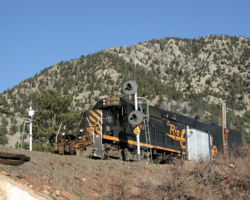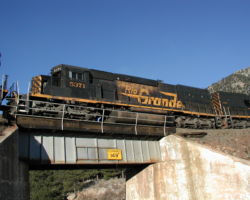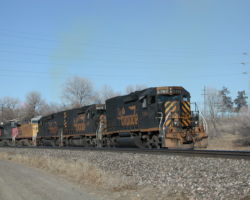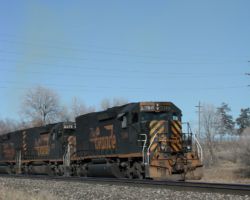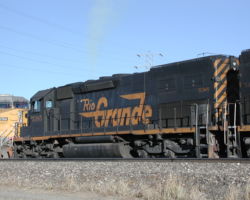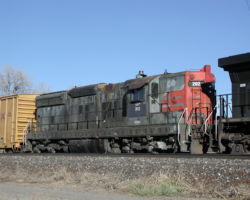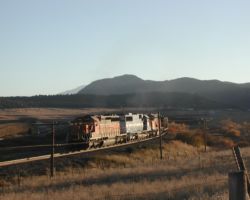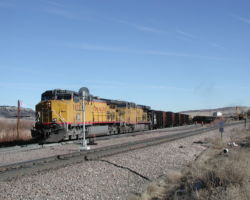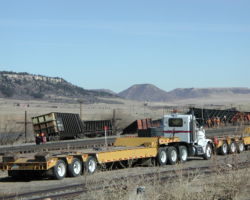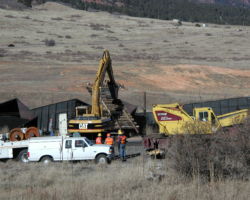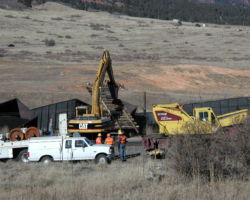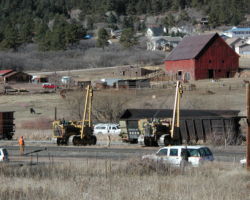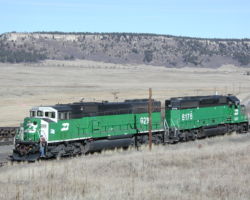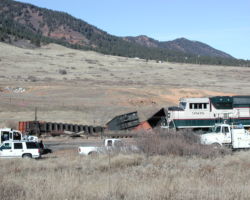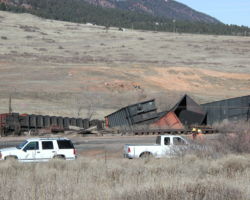Tunnel Motors on the Moffat
Anyone who knows me knows I hate mornings. I’m cranky, irritable, and unproductive if you wake me up too early, not to mention I’m tired the rest of the day. There’s almost nothing that will covince me to leave my nice warm bed in the morning – the opportunity to catch D&RGW tunnel motors in the morning light and work calling are about the only two things I can think of. So last night, when I noticed that D&RGW 5390/5371/5385 were working east, and didn’t leave Grand Junction until after 10pm, I decided to fight the urge to sleep in on Saturday and head up to Denver.
Five thirty this morning rolled around, and I begrudgingly rolled out and wandered in to check the UP Public Trace. Sure enough, they were about where I expected them – somewhere west of Kremmling (I think Bond, but honestly I wasn’t awake enough yet to really make sense of the data, just to remember that it was about what I’d expected from the night before). Once I showered, packed up the camera/scanner/laptop/batteries, and dressed, the clock was pushing six, so I decided to check one more time. The results opened my eyes a bit – Kremmling, traced at 5:52am. @#$@! It’s making better time than I thought, and I still needed to stop for gas. Understand that from my house in the Springs to the mouth of the Moffat is about 100 miles even, and I’d originally hoped to catch the motors around Pinecliffe somewhere. So, I flew out the door, down to the local Seven-Eleven, filled the truck, and headed for Denver as fast as I reasonably could. One thing I found odd – I was getting passed by an inordinate number of railroad vehicles, mainly BNSF. Oh well, maybe some sort of weekend maintanence blitz, I thought. Well, that turned out to be very wrong, but that’s in part 2.
Driving north through Castle Rock, I noticed a BNSF junk train with three Dash-9s on the “rear” and two of the standard Sedalia pusher SD40s on the “front” – front and rear being denoted on which way he was actually going. Strange, and everyone on the scanner was talking about backing him to Littleton and crossing him over. I assumed that there was some sort of issue with either the southbound main or the train in question – something requiring running down the wrong main. No clues offered by the crews or dispatcher yet over the radio.
About two miles south of the 470 interchange, I pulled over and checked the morning Locotrace from my phone (I’m sorry, but cellular packet data phones are absolutely wonderful for railfanning when you have a few toys rigged up to help out), since I know it runs at 7am. Good – the tracer still showed his last position as Kremmling at 5:52am MST – maybe they put him in the hole or something.
With a sudden horrifying apprehension, I realized about five minutes later that DRGW.NET is still running on Central Time, and the trace did me absolutely no good (being at 7am CST) – it ran about the same time I’d left home. I called home to have Michelle run a trace on 5371, and sure enough – at 7:01am MST, he’d passed East Portal. A few minutes later, I heard the detector at MP39.2 go off (via a repeater, obviously – I was way too far away to hear it directly). Shortly after that, I learned why all the strange behaviour on the Joint Line – there’d been a derailment somewhere down south on the southbound main. No clue where, yet, but it did sound like an interesting thing to check out later in the day.
Around 8:00am, after sitting in a traffic jam at 470 and I-70, I finally arrived at the turnoff to the road for Plainview. Since I hadn’t heard the detector around MP22 go off, I assumed that the three motors and whatever else were still coming down the hill. No sooner had I come to a temporary stop to consider what to do than I heard “DRGW5390 – Highball Plain” come over the radio. Once again, a bit of panic set in – I really didn’t have a plan. I would have preferred Blue Mountain crossing, but unfortunately the sun wasn’t high enough in the sky by this point to light it. So, the Colorado 72 overpass would have to do. Parking on the west side and running back to the southeast, the three lights on the front of 5390 were already visible coming out of Tunnel 1, though the unit itself was still in the shadow…
Before long, 5390 and kin, along with some miscellaneous SP/UP units, proceeded across the bridge, the hum/whine of dynamics and the smell of warm brakes filling the air. (Photo #1 / #2) At the end of the string of motive power, though, was a very unusual creature – a Southern Pacific SD7/9-ish thing. My spotting ability with early diesels is very limited – don’t ask me to tell you the differences between extremely similar units – such as SD7/9s or F3/7/9s or E5/6/7/9s. It’s not my era, and I haven’t seen more than a handful of examples of some of these in my whole railfanning life. Modern units, though – okay, who wants to start counting the number of doors and grilles? Nonetheless, I do still love watching early power in action, and will go a good deal out of my way to find it – and here it was, unexpectedly in front of me… By the time I’d noticed it, however, it had passed over the bridge and was at completely the wrong angle for any sort of photograph.
From here, I worked back towards Rocky and Leyden. First, I stopped along side Colorado 72 at a bend in the line, hoping to get a near “head-on” shot with a little help from the curvature and a big telephoto lens. However, I misjudged the angle of the line, and quickly determined that the lighting from the highway side would be somewhere between horrid and completely unusable. Back in the truck, I decided to try my old standby location for trains coming down the hill – the 80th Street crossing.
Once again, I feared when I arrived that the light would be almost unusable because the line heads southeast at this point. However, upon getting out of the truck, I found the light to actually be decent, though far from great. However, after a fair wait, there was still no sign of 5390 and friends. It’s usually a sure sign something’s about to happen when the other railfans start pouring in, and about five minutes after I arrived it started. As I heard the slack run in to the train just around the corner (meaning they’d put him in the siding here at Leyden to wait for something), a very, um, bold guy in a green Pontiac decided he’d just drive down the maintenance road to get photos. Anybody who knows me and/or has ever read my reports knows that typically I avoid intruding/trespassing on railroad space unless a) it’s a very minor act that’s not putting anyone at risk, like walking down the ditch some distance (rather than say, out in to the middle of North Yard, which would just be plain dumb) and b) I’m reasonably sure that no one will really care (ie, not getting in the way, not being in a position that they consider a threat). Driving down a maintenance road just seemed a good way to get a lot of attention very quickly, so I had to wonder about this guy – that said, I have no clue who this person is, and knowing my luck, he’s probably reading this. Oh well, I guess that’s the danger of posting most of my thoughts in a public forum…
Still holding my own back at the crossing, a few minutes later two more railfans showed up – this time on foot. As it turned out, these two were Paul from Arvada and “Intermodal” Matt – two D&RGW list members that I was glad to finally meet. (Side comment – that’s the best part of the D&RGW list and everyone on it – finally meeting these people in person and matching the faces and personalities with the posts you’ve been reading for years). These two had a more rational approach, in my humble opinion, of walking down the side of the maintenance road back to the units, so I decided to tag along on the way back. With the train tied up on the siding in very good light, this yielded quite of bit of conversation and excellent roster shots of all the units. While obviously I can’t condone walking on to railroad property (even maintenance roads and ditches) in any way, this time it was well worth it in terms of results. (Photos #3-6)
At this point, Paul and Matt said goodbye and continued on with their day, and I was left with a choice – I could either go north to LaSalle and check out the recently-revived DRGW 3060, or head back south and look for the derailment. Figuring that 3060 would live to see another day (As a warning, this is not really a good assumption to make – I did this one time previously and the unit was repainted within a week.), I decided to head out to see what was causing all the problems on the Joint Line.
A Derailment in Palmer Lake
So I finally head south back down the Joint Line, looking for this derailment. Bear in mind I have absolutely no clue where it is, and am solidly anticipating that it’s out in the middle of the open (and inaccessible) area immediately south of Greenland. Absolutely no way to get back there and get a shot. None, zilch, zip, nada – well, unless you know the rancher, I suppose. Of course Mr. Murphy and his law dictate that this is where the derailment will be, both from a railfan and a railroad perspective, right?
Actually, the main reason I thought this was on the way out that morning I’d seen a southbound BNSF coal train stopped just past the Greenland crossing with several trucks around it. I suspected this may have been the problem train. However, as I drove south this time (on the old back road between Larkspur and Palmer, I believe it’s Colorado 18), I came up behind (and eventually passed) a UPRR MOW truck with a large, bouncing section of new rail chained to the top. It was clearly not headed down towards Greenland, but rather into Palmer Lake itself, so I hoped to myself that the derailment would be in easy camera range. However, the truck did help confirm the suspicion I’d heard earlier on the radio that the derailment was caused by a broken rail.
Initially, upon cresting the hill and expecting to see cars strewn all over the place, I was disappointed. Nothing at all visible – just the usual wide open valley above town, and the two Joint Lines snaking through it. For those of you who have never been along this road, Photo #7 is roughly what it looks like when you first crest the hill and can look down over the valley. (Yes, this was actually taken on October 20th, 2000, not today, but I like the photo and this was a convienent way to weasel it in!) Palmer Lake is off to the top right, and you can see the line (and train) snake down to it. As I got closer to Palmer Lake itself, though I could see considerably more action, including a crew working on one of the rails. Then, as I rounded the final curve before town, I saw the mess – about 10 coal gons, all twisted and piled on each other, along with two others ahead of the pile sitting on their sides. From this road, everything was extremely backlit, and UP crews were everywhere. Rather than make a further nuisance of myself, I pulled forward and across the line into the parking lot for the park that surrounds Palmer Lake.
Looking back down the line (Photos #8 / #9), there were UP trucks and men everywhere, along with the pile of cars and the front of the train, which was still on the rails – this included UP 7153/7078, along with the first five cars. Apparently, somewhere between 3:30 – 4am this morning, it had gone over a broken rail. The lead units and the first five cars stayed on, while the next 10-14 cars jumped and wound up in various positions. The key goal at this point seemed to be to move a great many pieces of panel track that had been stacked almost right at the derailment site (from the clean-up of another derailment at almost the same spot about a year earlier, I believe). These were blocking access and preventing them from dragging the pile of damaged cars out of the way.
Meanwhile, the first two cars to come off the tracks (slightly ironic that they were both D&RGW) were both being dumped and dragged away from the site. Because they didn’t pile up, but rather just fell over, these were fairly easy to get out. It’s a very impressive sight to watch a pair of Cats hook on to a car, twist and torque it to pull it over, dump and spread the contents, and then drag the car over the bed of coal. (Photo #11 is DRGW 900877 on its way over – this is the most dramatically I’ve ever seen a car twisted except in a derailment itself…) Both of the “free” cars were dumped this way (Photo #12) and dragged off while I watched from above the wreck along the side of County Line Road. These were then presumably going to be loaded on the heavy-duty flatbed trucks that had been parked nearby (see Photo #8/9 again).
I waited and watched until my fingers were numb from the cold (as an Iowan, you’d think I’d be used to far worse cold than this – but also as an Iowan who’s lived with blizzards and the sometimes subarctic cold of winter on the northern plains his whole life, you’d think I’d be smart enough to wear gloves…), and then I waited some more. Actually, this is the first derailment cleanup I’ve ever been able to watch and remember. The only other one I’ve ever seen was in my home town of Walcott, IA, when the Rock Island dumped a good part of a westbound off the line in the middle of town, only a few blocks from my house. Needless to say, this was a very long time ago, and I was quite young at the time – I don’t remember a thing, despite my parents’ insistence that I was fascinated by the whole works. Michelle finally showed up with my real camera and much larger lenses (I’d been shooting digital-only all morning) about 11:30, and we continued to wait and watch for another hour-and-a-half or better. In that time, some of the rerouted southbound BNSFs managed to work their way through on the northbound main, of course being talked through by the foreman and the dispatcher the whole way.
One interesting thing of note – because siding space was at a premium, two sets of helpers were eventually stored in the house track at Palmer until they could be sent back north. I only mention it because this track is overgrown and I have never seen anything on it in any of my trips to Colorado nor the six months I’ve now lived here. Honestly, I was a bit surprised it held under the weight of an SD60M. (Photos #13/14) After two BNSF southbounds (Photo #15), though, the cold and my hunger were getting the best of me, and I decided to return home for the day. Besides, after the early morning and the late night before, and I needed a nap!
This work is copyright 2024 by Nathan D. Holmes, but all text and images are licensed and reusable under a Creative Commons Attribution-NonCommercial-ShareAlike license. Basically you’re welcome to use any of this as long as it’s not for commercial purposes, you credit me as the source, and you share any derivative works under the same license. I’d encourage others to consider similar licenses for their works.
